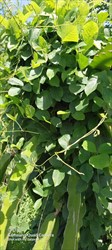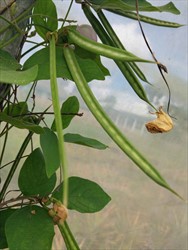- Worldwide distribution. In Australia, Fiji, FSM, French Polynesia, Guam, New Caledonia, Northern Mariana Islands, Palau, PNG, Samoa, Solomon Islands, Tonga.
- Aggressive fast-growing vine, tolerating range of soils, levels of shade, used widely in the wet tropics as ground cover in plantations and forage for cattle, escaping, leading to weediness along roadsides, riverbanks, and crops (e.g., banana, sugarcane). An environmental weed invading disturbed forests, preventing regeneration.
- Stems, thin, hairy, branching, becoming woody. Leaves with three leaflets, tips pointed, rounded at base. Flowers in small groups, pink to mauve (sometimes white) with central keel and lateral petals. Pods flat, long, thicker at margins, with about 20 brownish-red seeds with black streaks. Strong tap root.
- Spread: seeds attached to shoes, machinery, garden waste. Long distance also as seed; readily available on Internet.
- Biosecurity: Many countries permit introduction, but (e.g., in Australia) people obliged to minimise risks associated with invasive plants under their control.
- Biocontrol: none.
- Cultural control: hand-pulling; collect stem pieces and burn. Avoid using topsoil where centro grown previously.
- Chemical control: in Australia, several herbicides allowed under PER11463 in non-crop situations: (i) triclopyr + picloram (basal bark); (ii) glyphosate (Cut stump/paint & Cut, frill or drill), or iii) metsulfuron-methyl (Cut stump/paint & Cut, frill or drill).







